
Brandenburg, officially the State of Brandenburg, is a state in northeastern Germany. Brandenburg borders Poland and the states of Berlin, Mecklenburg-Vorpommern, Lower Saxony, Saxony-Anhalt, and Saxony. It is the fifth-largest German state by area and the tenth-most populous, with 2.5 million residents. Potsdam is the state capital and largest city. Other major towns are Cottbus, Brandenburg an der Havel and Frankfurt (Oder).
Duchy of Lauenburg is the southernmost Kreis, or district, officially called District of Duchy of Lauenburg, of Schleswig-Holstein, Germany. It is bordered by the district of Stormarn, the city of Lübeck, the state of Mecklenburg-Vorpommern, the state of Lower Saxony, and the city state of Hamburg. The district of Herzogtum Lauenburg is named after the former Duchy of Saxe-Lauenburg.

The Hamburg Wadden Sea National Park is the smallest of the three German Wadden Sea National Parks which protect the single ecological entity of the Wadden Sea reaching from Den Helder to Esbjerg.

The Bay of Lübeck is a basin in the southwestern Baltic Sea, off the shores of the German states of Mecklenburg-Vorpommern and Schleswig-Holstein. It forms the southwestern part of the Bay of Mecklenburg.
Niendorf may refer to the following places in Germany:
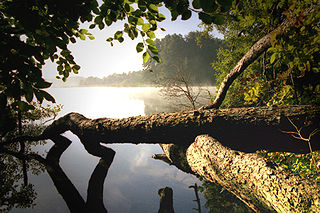
Schaalsee is a 24 km2 (9.3 sq mi) lake in Germany. It forms part of the border between Schleswig-Holstein and Mecklenburg-Vorpommern. The town of Zarrentin is located on its southern shores. Other municipalities on the lake are Seedorf, Sterley, Salem, Kittlitz and Kneese.

Löcknitz is a river in northern Germany.
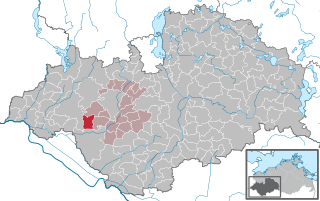
Pritzier is a municipality in the Ludwigslust-Parchim district of Mecklenburg-Vorpommern, Germany. The Pritzier municipality consists of three villages: Pritzier, Pritzier Bahnhof, and Schwechow.
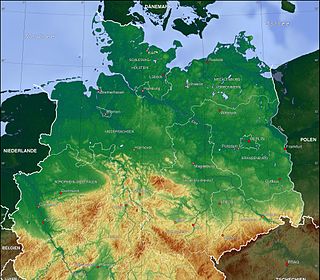
The North German Plain or Northern Lowland is one of the major geographical regions of Germany. It is the German part of the North European Plain. The region is bounded by the coasts of the North Sea and the Baltic Sea to the north, Germany's Central Uplands to the south, by the Netherlands to the west and Poland to the east.
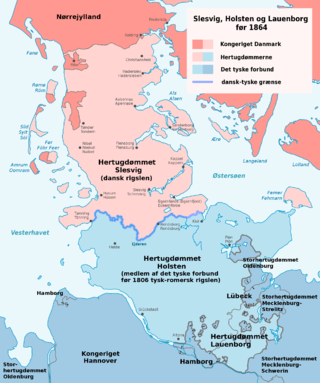
Jutland is a peninsula of Northern Europe that forms the continental portion of Denmark and part of northern Germany (Schleswig-Holstein). It stretches from the Grenen spit in the north to the confluence of the Elbe and the Sude in the southeast. The historic southern border river of Jutland as a cultural-geographical region, which historically also included Southern Schleswig, is the Eider. The peninsula, on the other hand, also comprises areas south of the Eider: Holstein, the former duchy of Lauenburg, and most of Hamburg and Lübeck.

The Lauenburg Lakes Nature Park was founded in 1961 and lies in the district of Lauenburg in the southeastern part of the German state of Schleswig-Holstein. It is right on the border with the state of Mecklenburg-Vorpommern in the Schleswig-Holstein Uplands, a Young Drift moraine landscape that formed during the Weichselian glaciation of the last ice age.
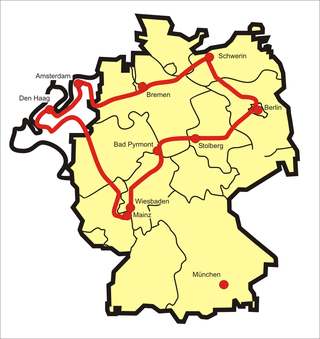
The Orange Route is a holiday route, that runs from Amsterdam in the Netherlands through North and Central Germany and returns to Amsterdam. It is 2,400 kilometres long and crosses the Netherlands and nine of German federated states. The Orange Route runs through towns and regions that linked the House of Orange-Nassau for centuries.
Ludwigslust-Parchim is a district in the west of Mecklenburg-Vorpommern, Germany. The district seat is Parchim, a branch office of the administration is located in Ludwigslust.

Boize is a river of Schleswig-Holstein and Mecklenburg-Vorpommern, Germany. It flows into the Sude in Boizenburg.
The Ruhn Hills are a terminal moraine ridge up to 176.8 m above sea level (NHN), which lies on either side of the border between the German states of Brandenburg and Mecklenburg-Vorpommern near Parchim. After the Helpt Hills they are the second highest points in the latter federal state.
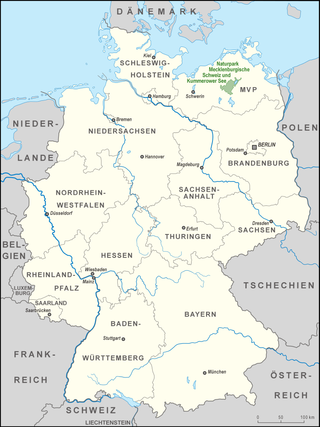
The Mecklenburg Switzerland and Lake Kummerow Nature Park lies in the northern part of the Mecklenburg Lake District in the districts of Mecklenburgische Seenplatte and Rostock in the German state of Mecklenburg-Vorpommern between the towns of Dargun, Demmin, Teterow, Malchin and Waren (Müritz). It was created in 1997. The total area of the nature park is 673 km2. 19 percent of this area is covered by woodland, ca. 10 percent by lakes and rivers, the rest is cultural landscape. There are 3 large lakes in the naturepark: Lake Malchin, Lake Kummerow and Lake Teterow. The Peene is the largest river in the park. The features that make it special are the large lakes, the riverine landscapes, the centuries-old oaks, the castles, the manor houses and their rural estates. The nature park is well known as a stopover for Nordic ducks. It is easily reached from the A 19, motorway junctions Krakow am See and Güstrow, or the A 20, junctions Tessin and Bad Sülze. The head office of the nature park administration is in Basedow.
The region of Griese Gegend lies in southwestern Mecklenburg in Germany. In the northwest and north the region is bordered by the River Sude, the stream of the Strohkirchener Bach and its continuation as the New Canal. The region's southeastern border runs roughly from the town of Ludwigslust to Dömitz, in the southwest the River Rögnitz forms the boundary of the Griese Gegend from Woosmer to Lübtheen. The region forms a large triangle.

The Schaalsee Biosphere Reserve lies in western Mecklenburg-Vorpommern on its border with Schleswig-Holstein. From 1952 to 1990 large parts of the Schaalsee landscape lay within the military out of bounds area of the Inner German Border. That state-imposed rest period enable nature to develop so that in the year 2000 this valuable area was designated as a biosphere reserve. On the Schleswig-Holstein side of the border is the Lauenburg Lakes Nature Park founded in 1961.

The Sude is a river in Mecklenburg-Vorpommern and Lower Saxony, Germany. Its source is near Renzow in western Mecklenburg. It flows through the lake Dümmer See, and continues past Hagenow and Lübtheen. It flows into the Elbe in Boizenburg.















